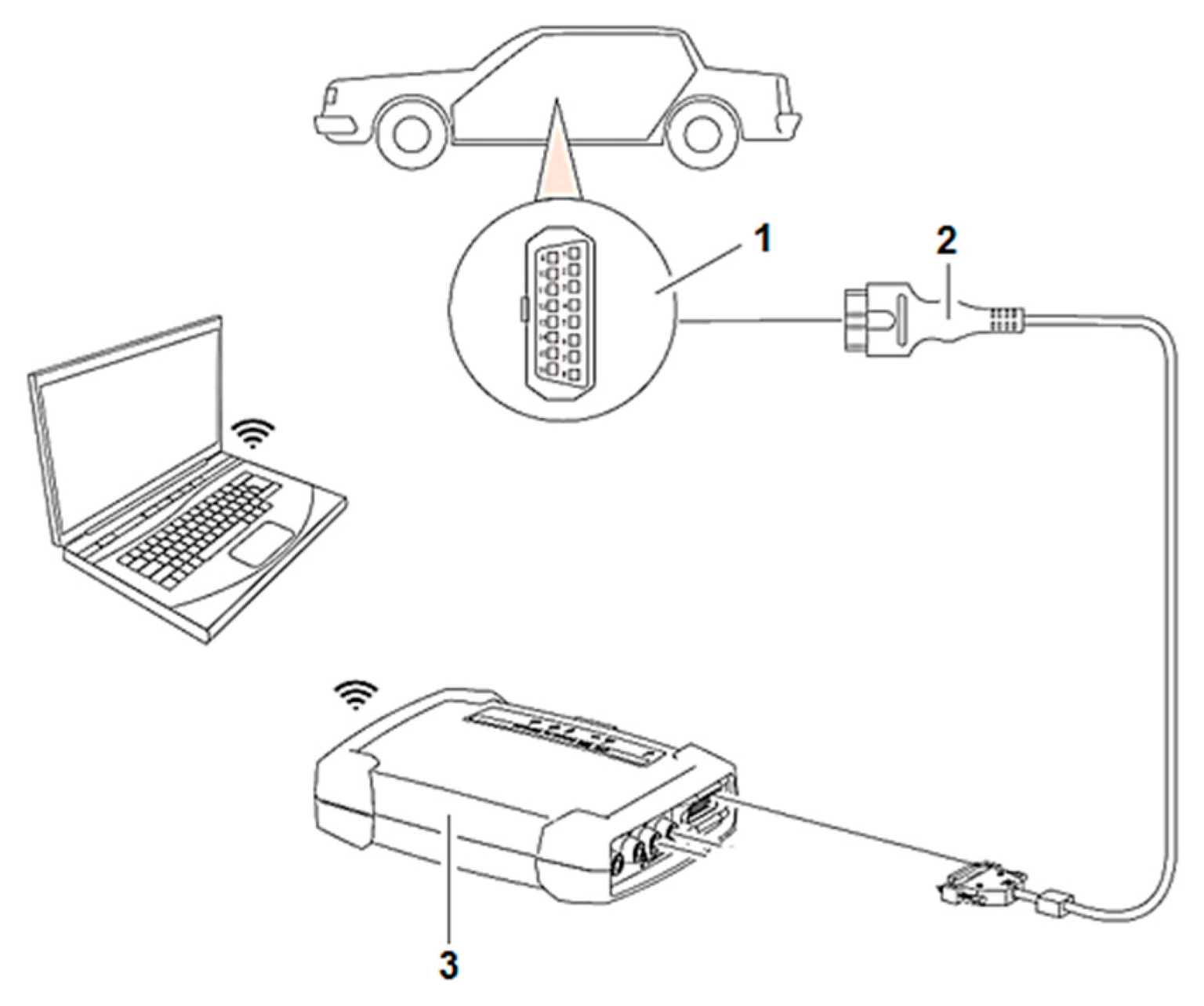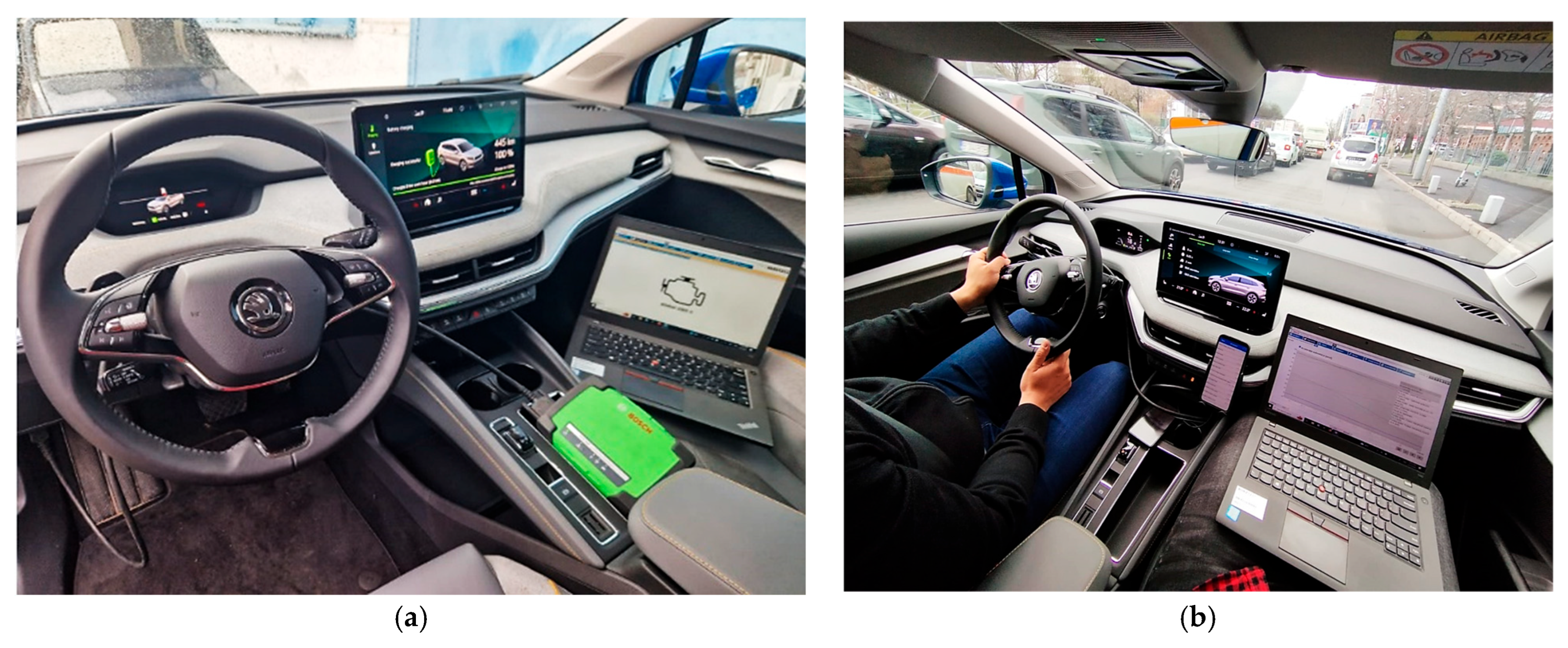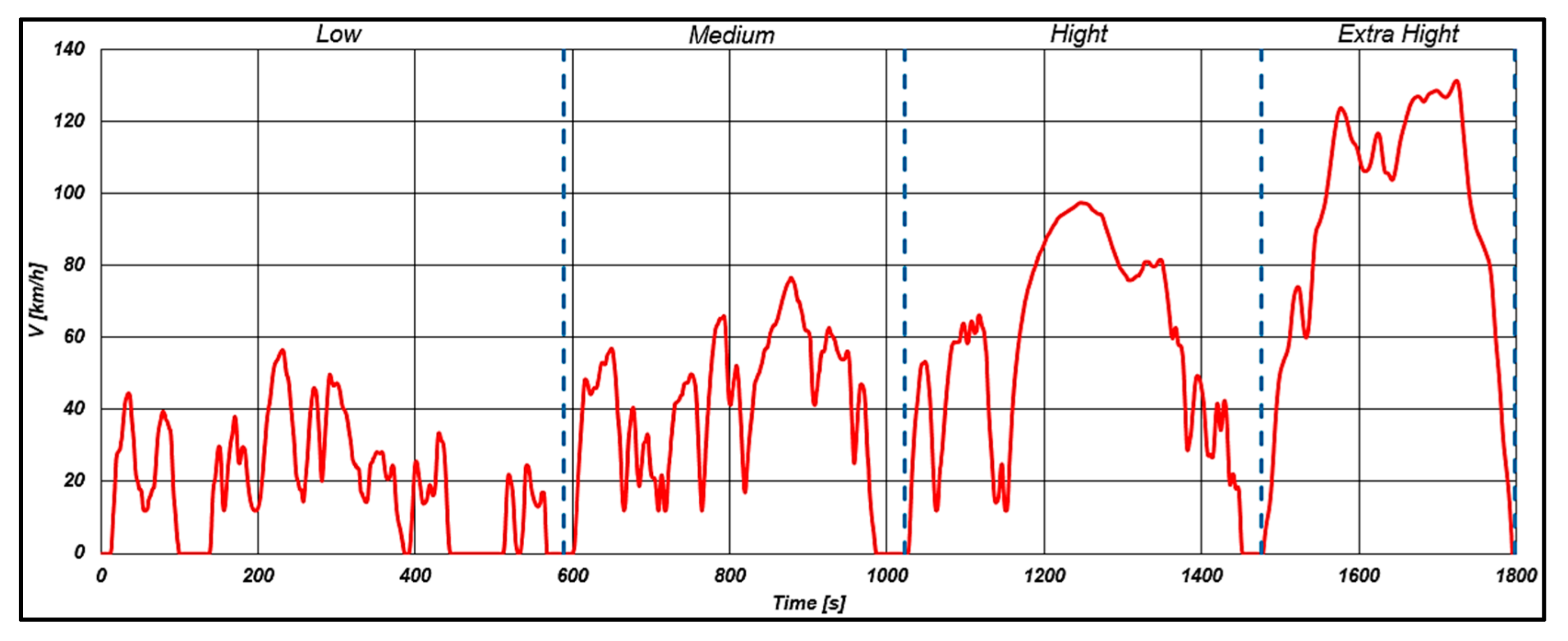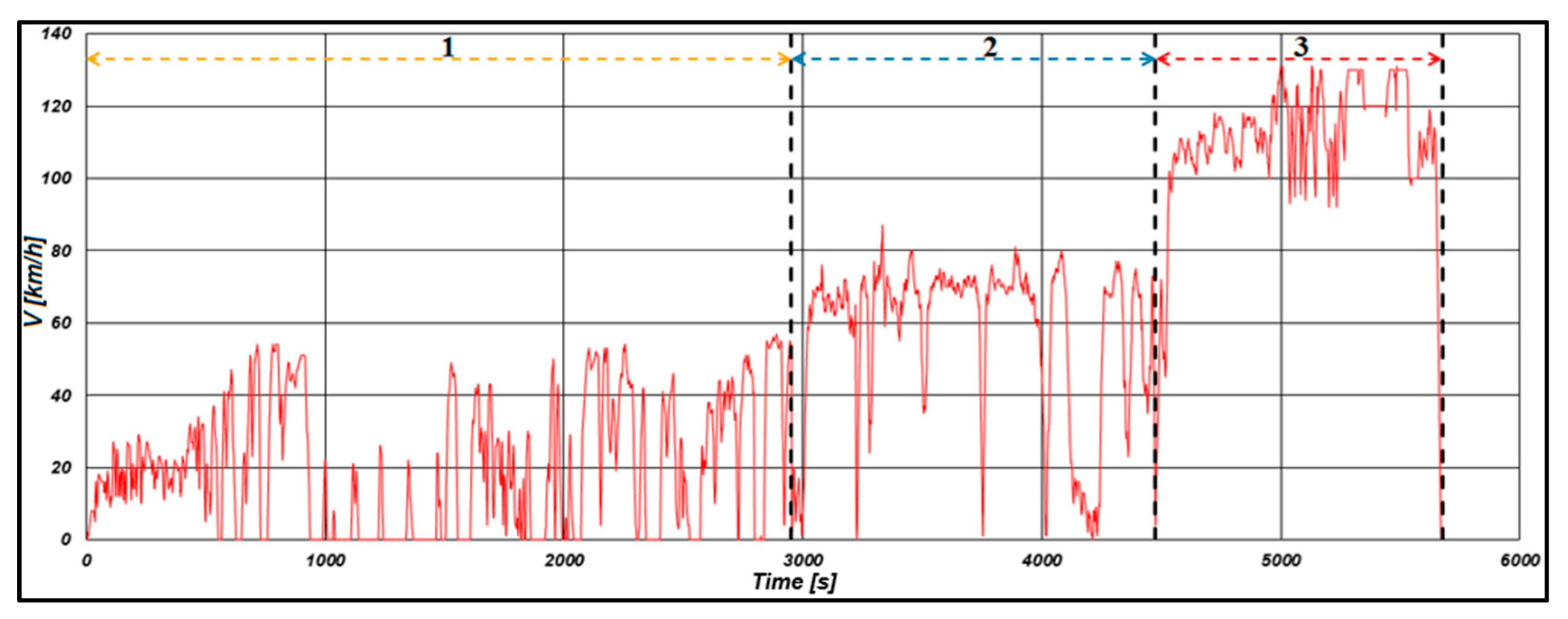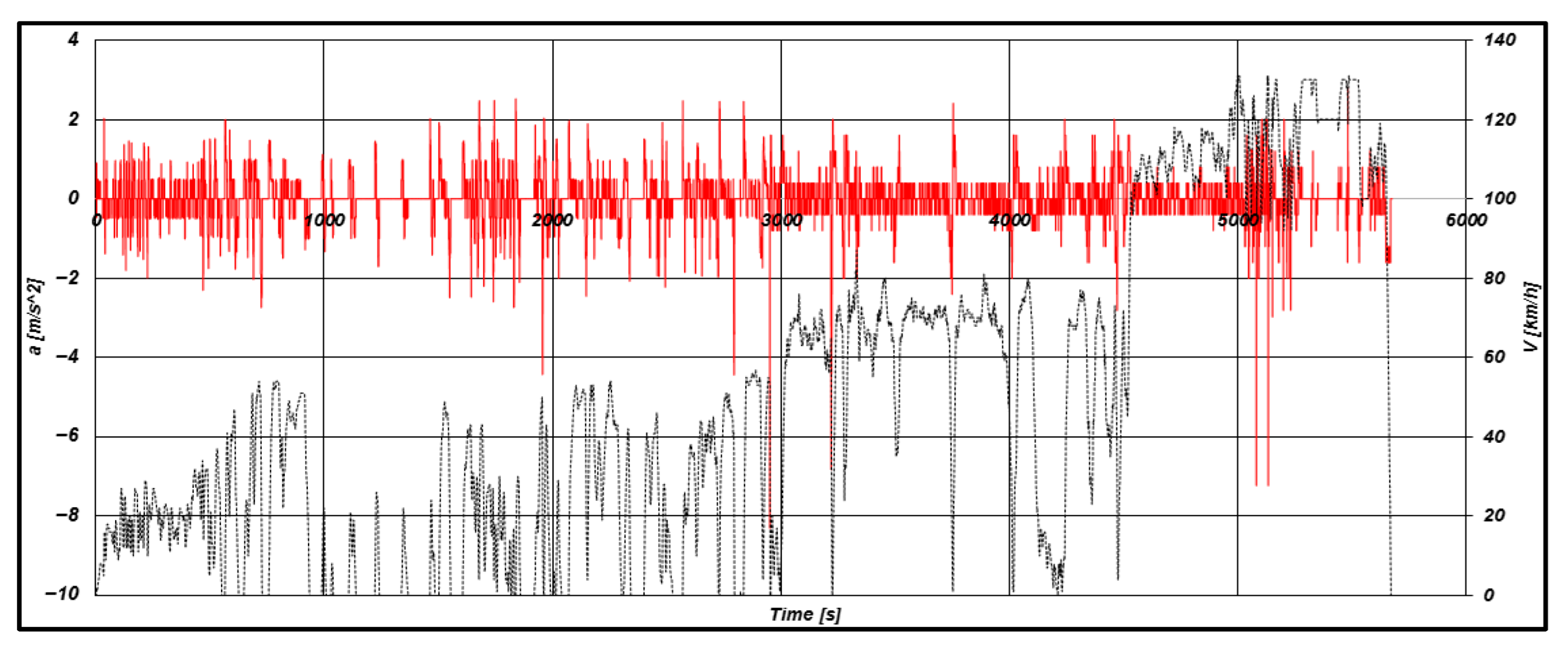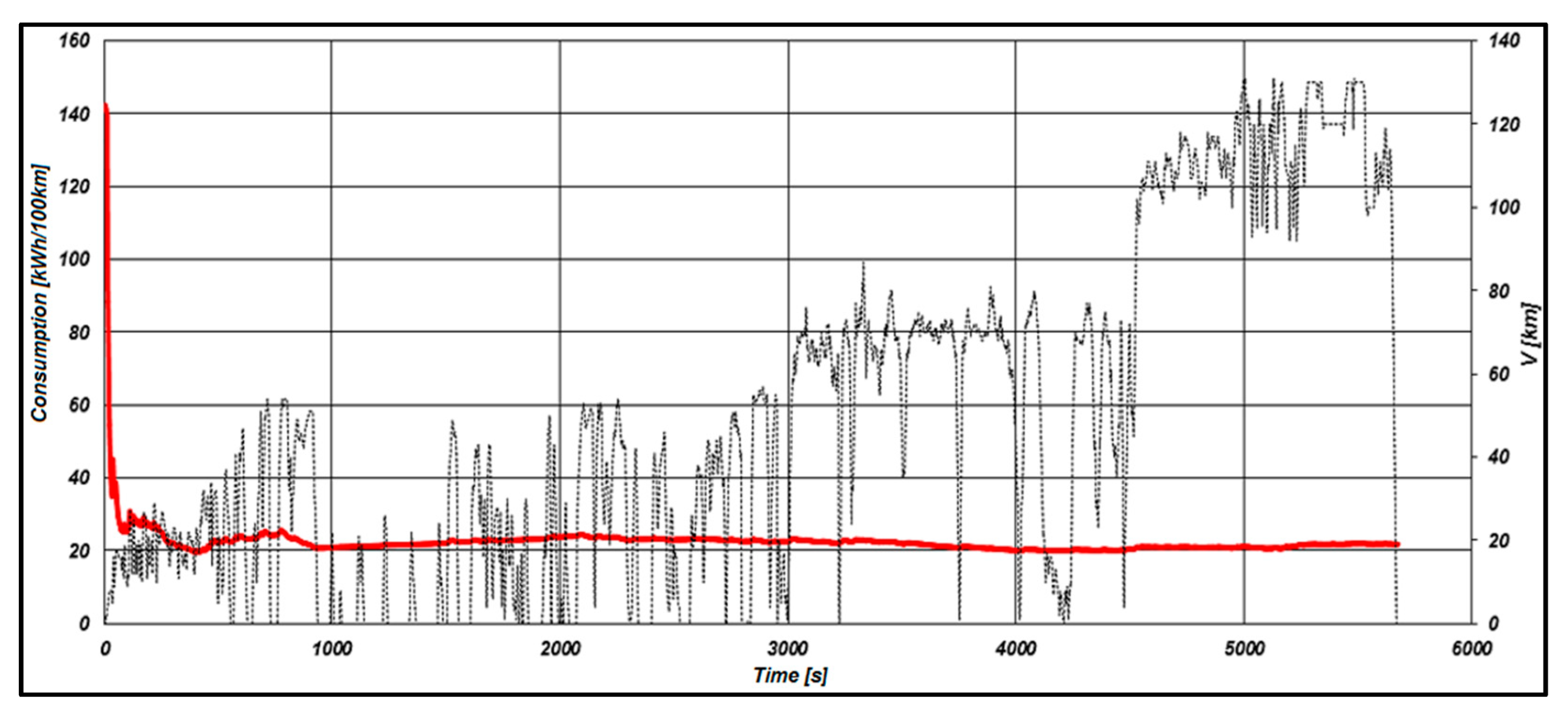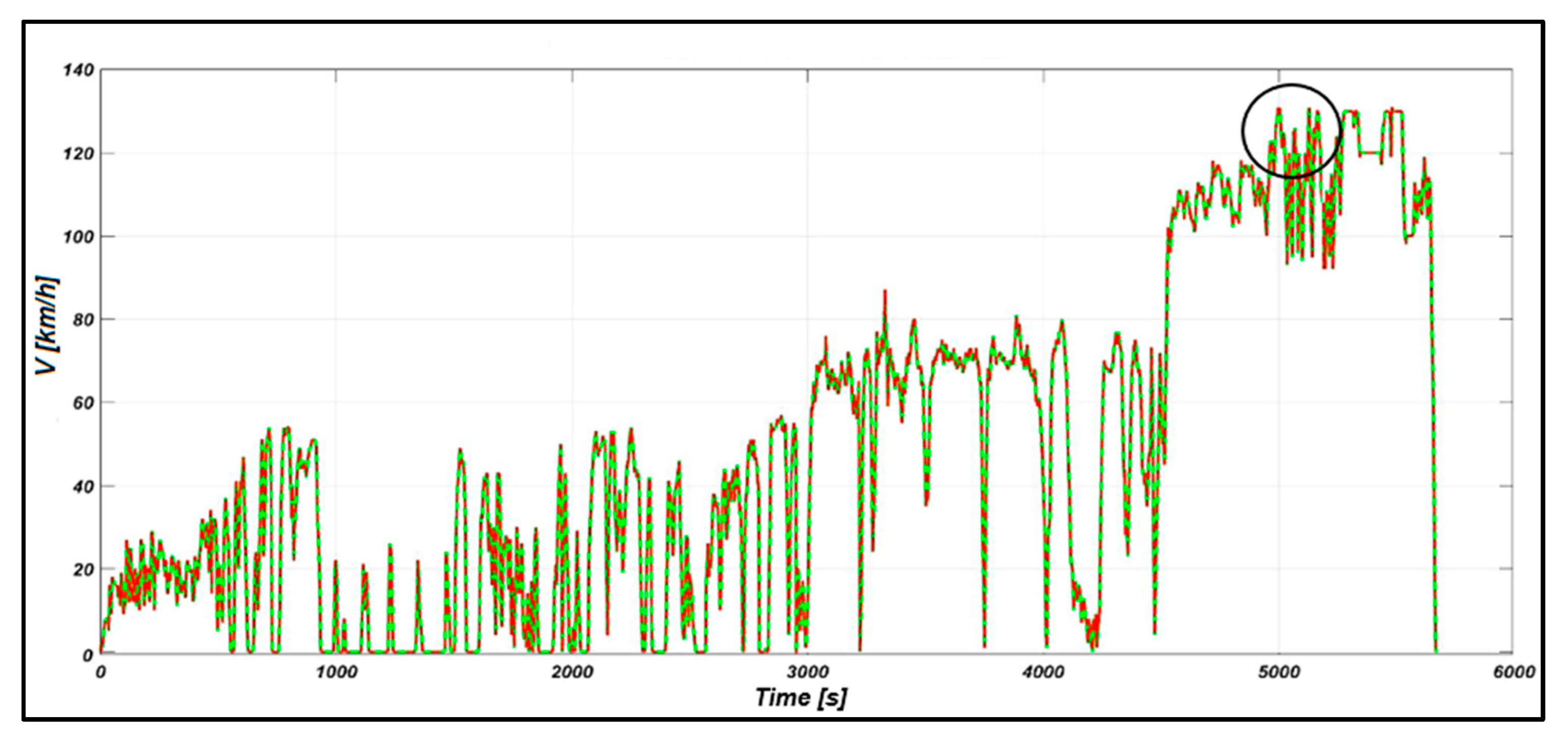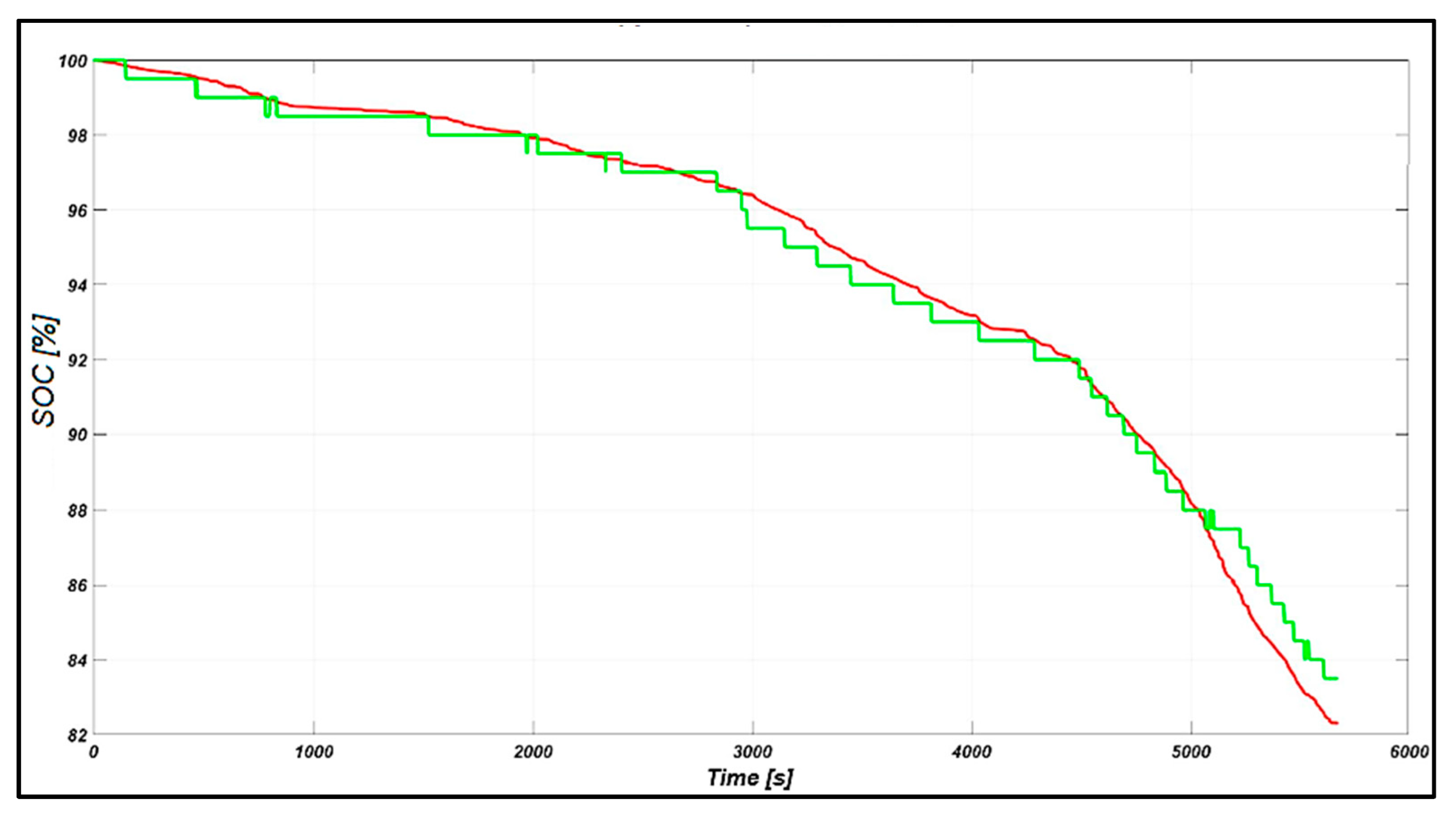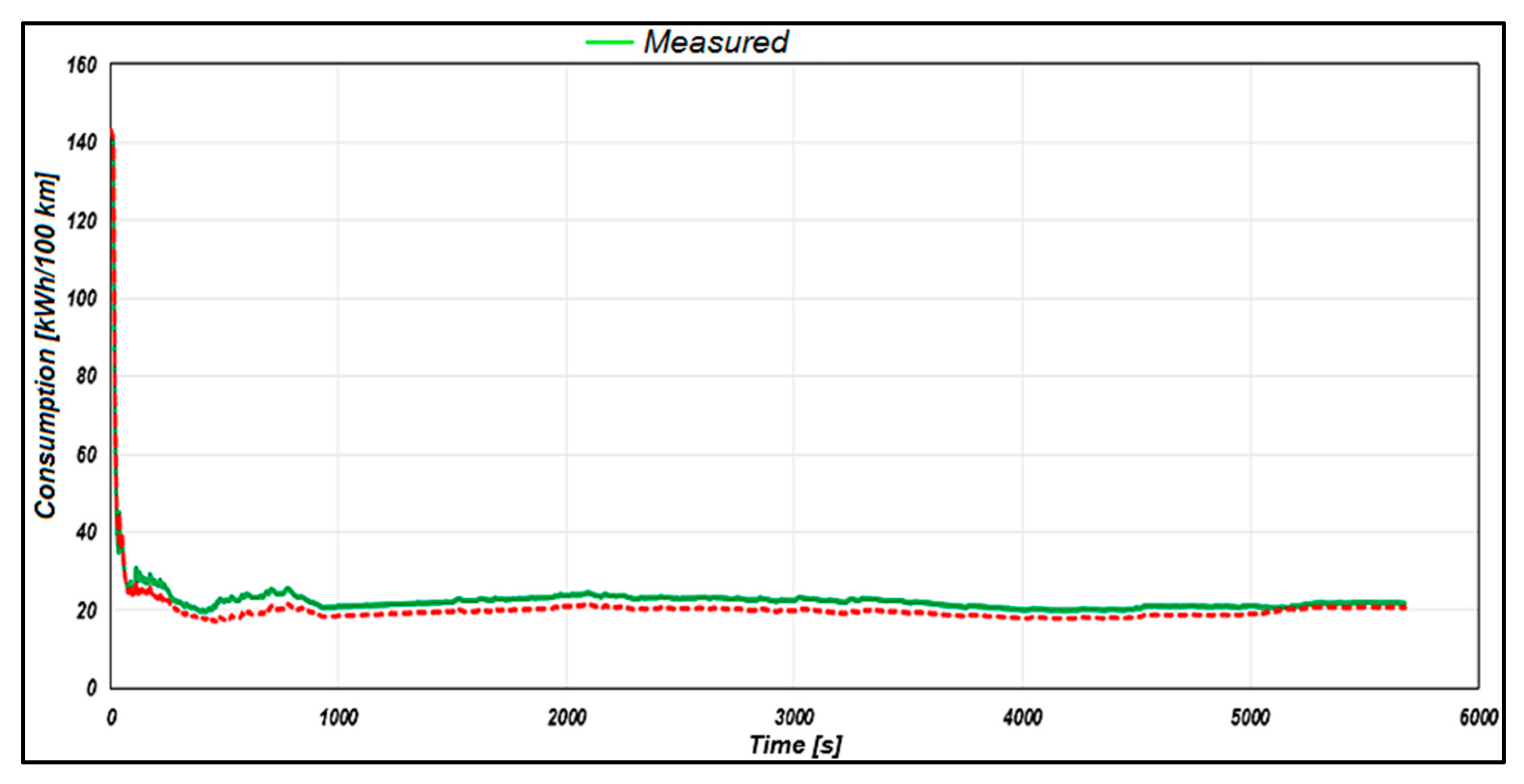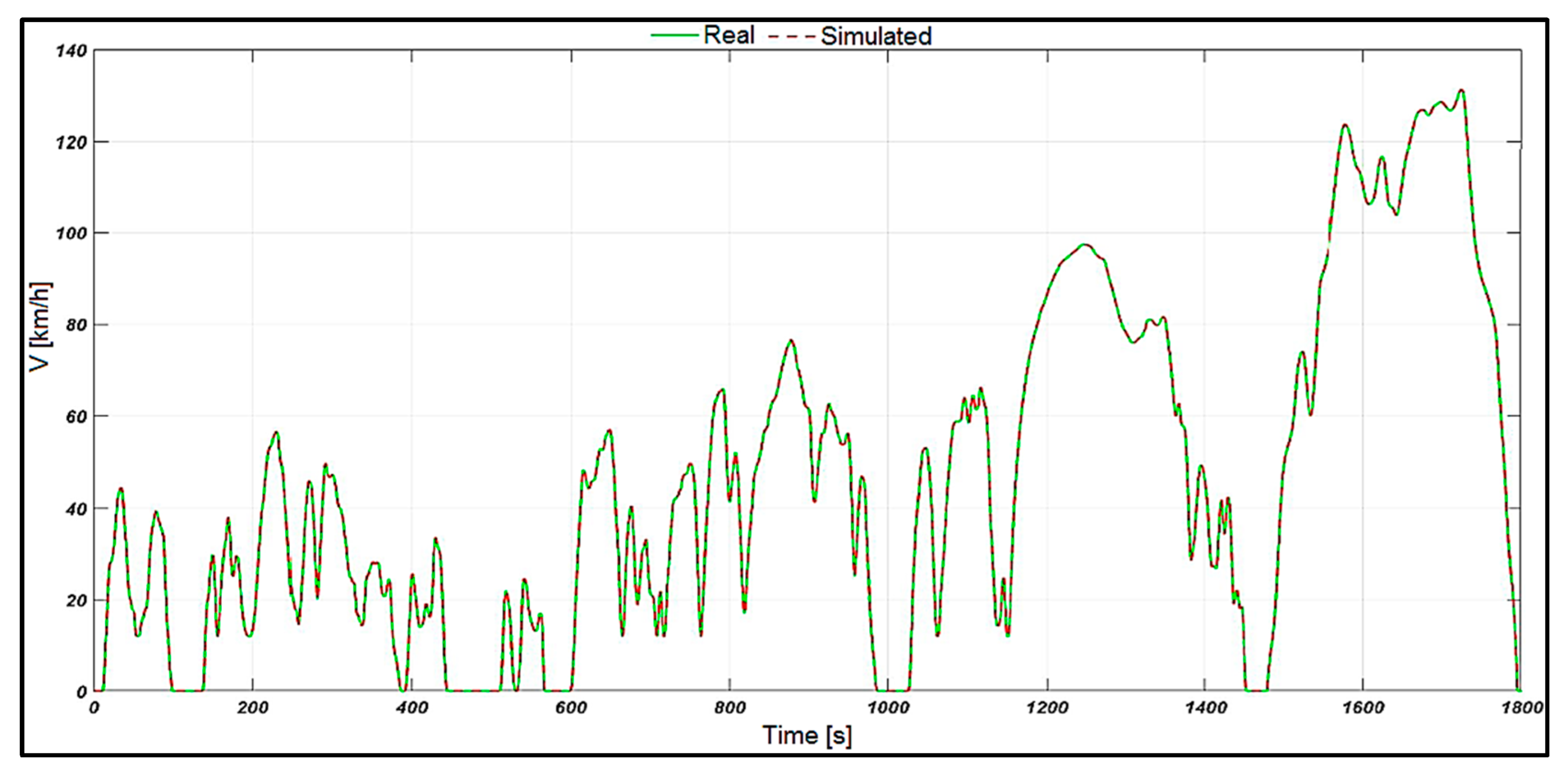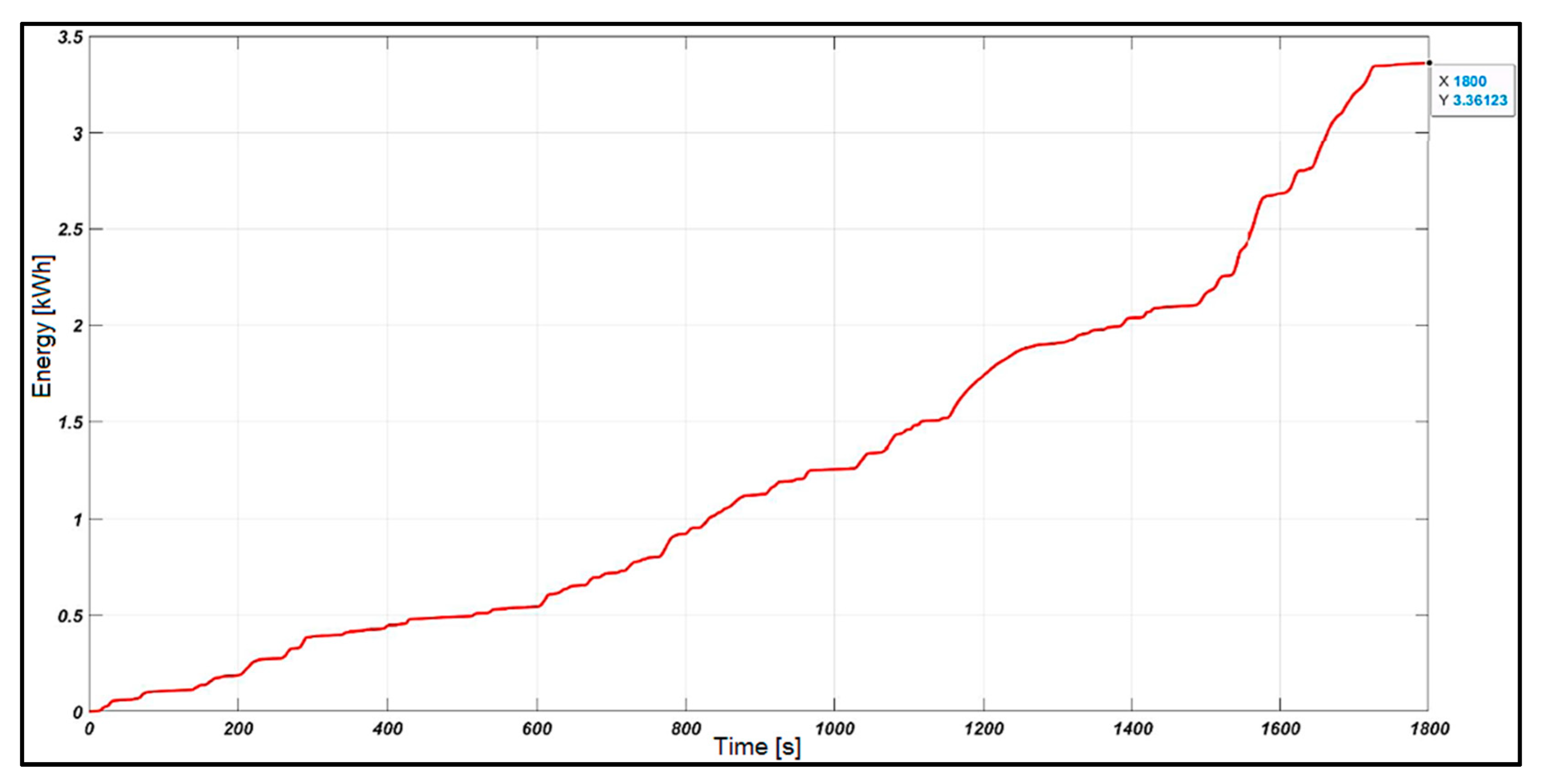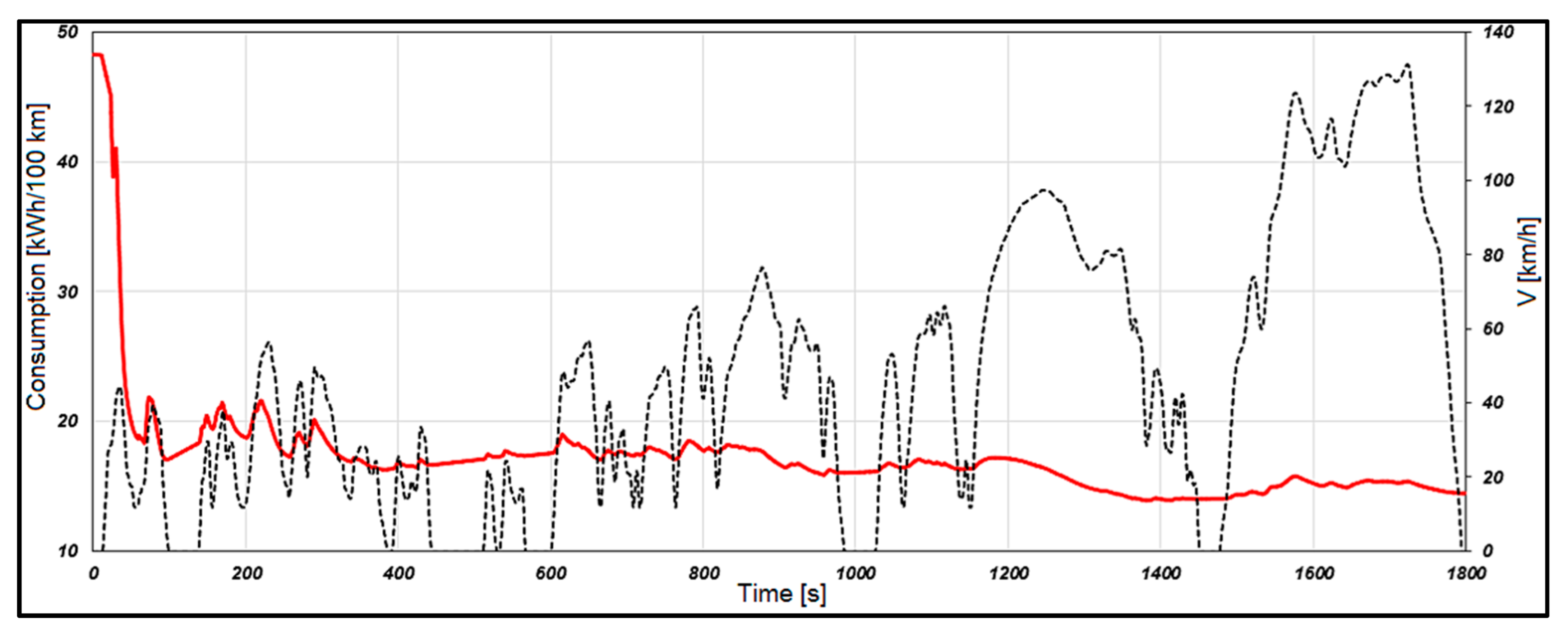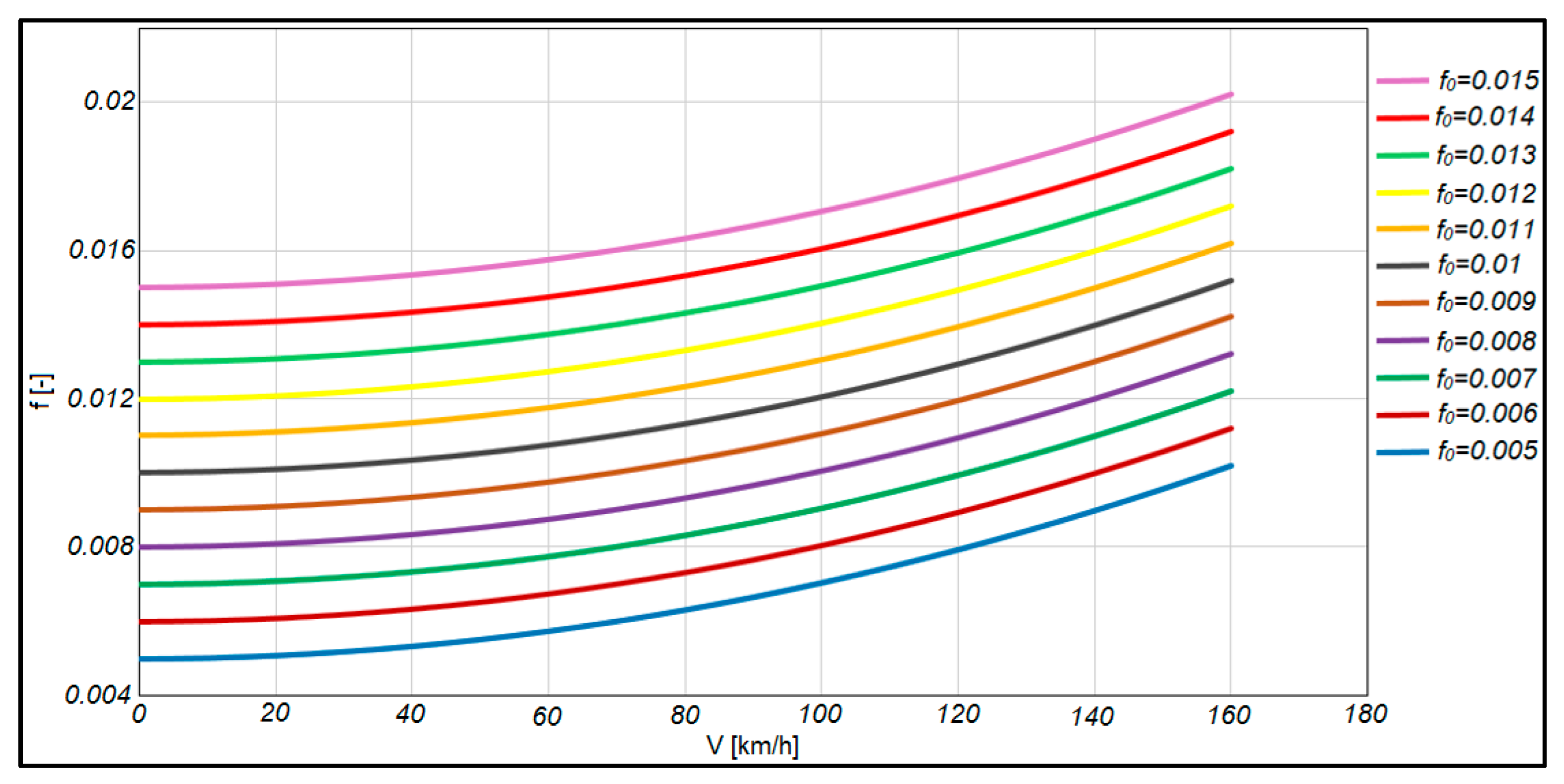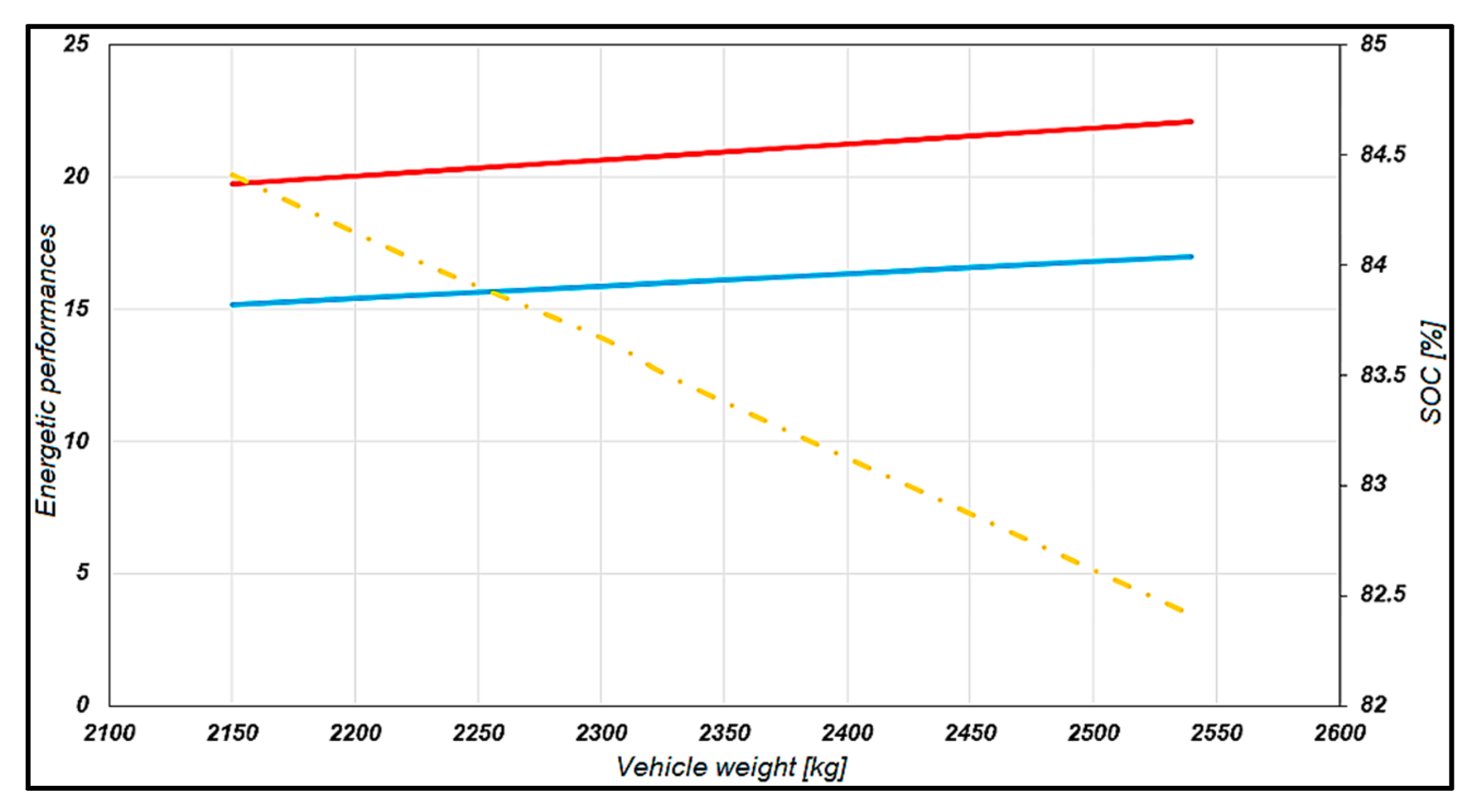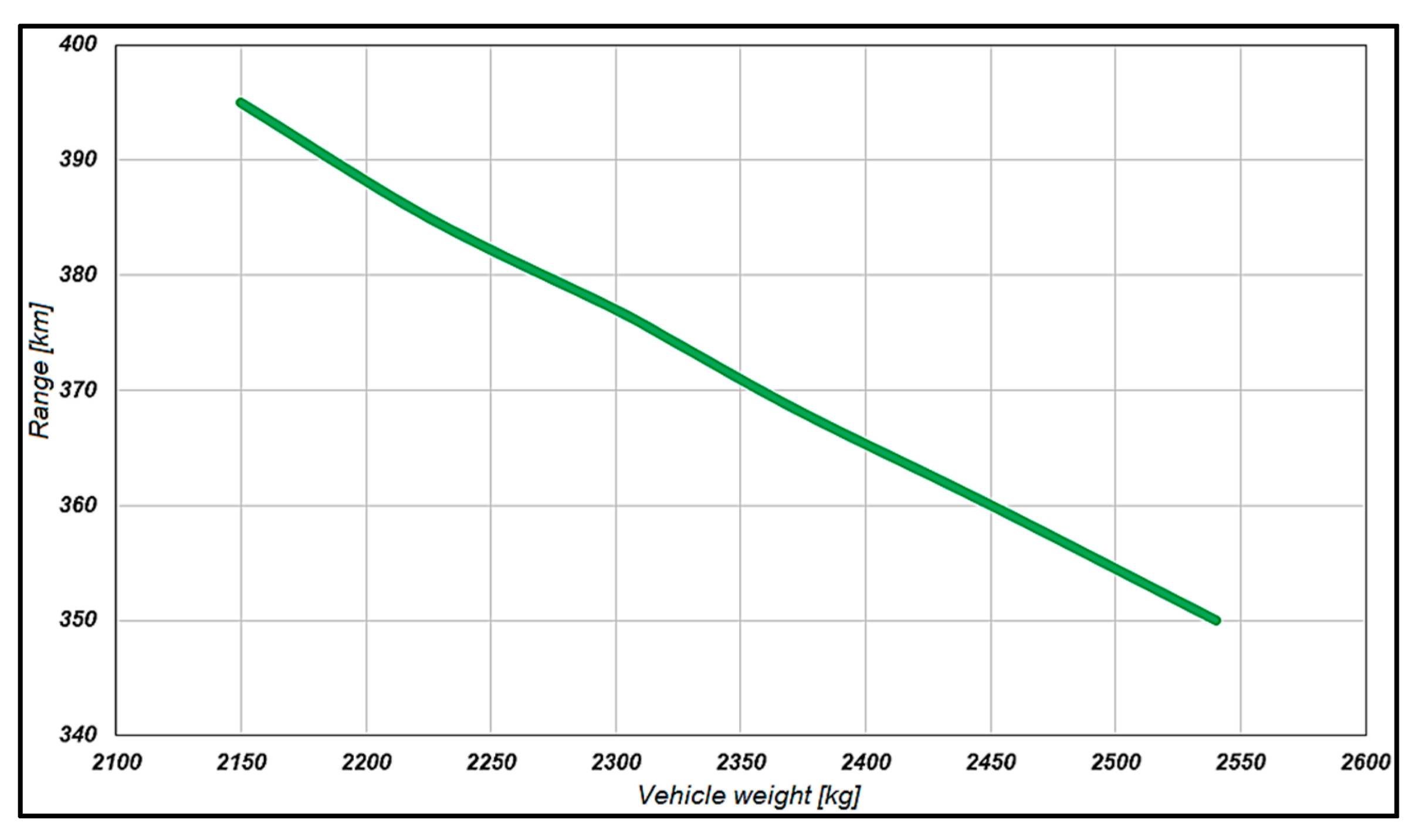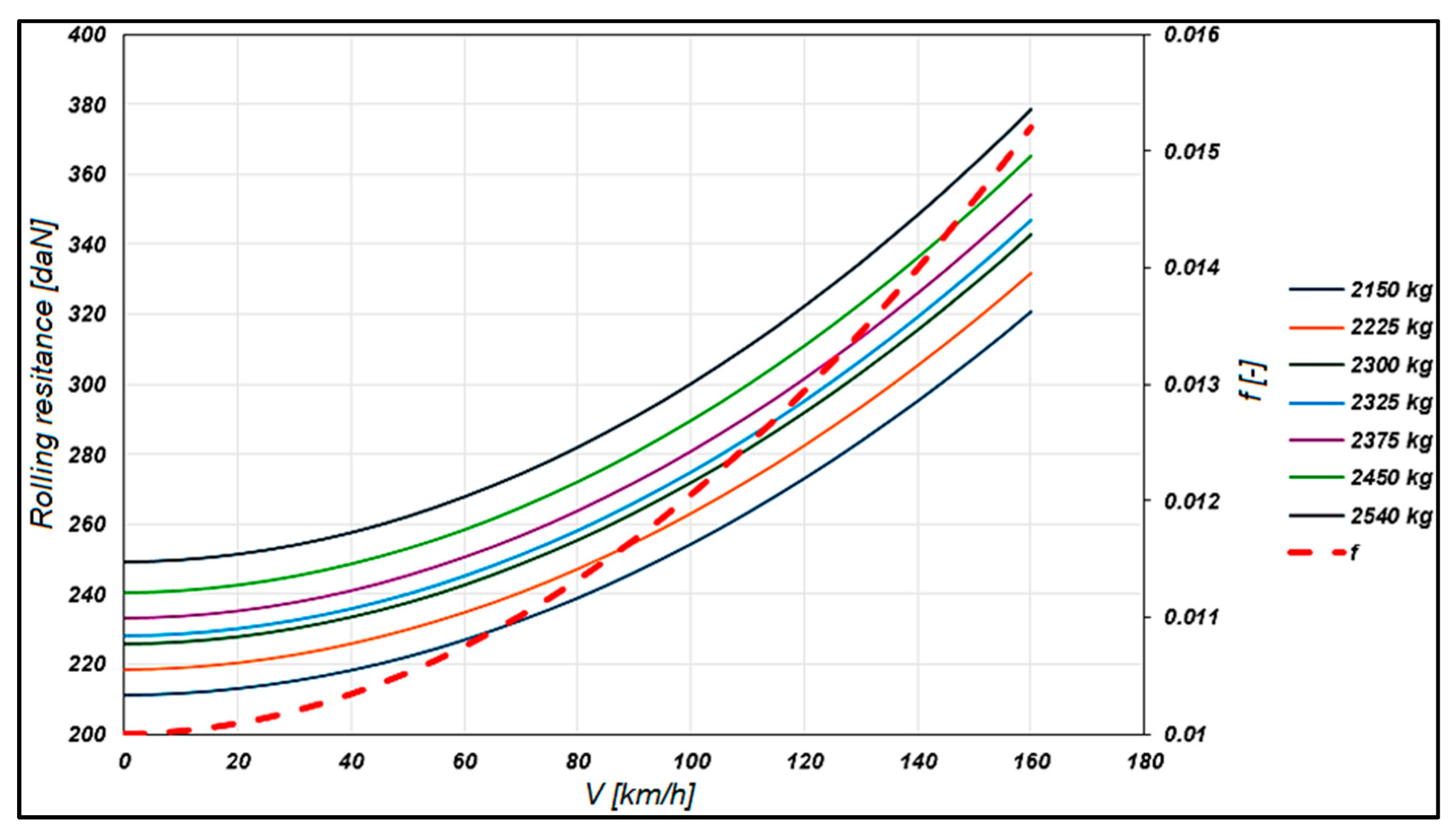1. Introduction
Determining the dynamic and energetic performances of electric vehicles (EVs) under real-world conditions is a topic of major interest in the specialized literature, given the accelerated expansion of electromobility and the need to understand the differences between the values obtained in standardized cycles and the behavior of the vehicle in everyday use. Studies have shown that parameters such as driving style, road profile, ambient temperature, and traffic density can influence the energy consumption of electric vehicles by over 20–40%, justifying the importance of real-world analyses [
1].
The wide-scale adoption of electric vehicles is influenced by a set of technical, economic, social, and environmental factors, each of which contributes to both the advantages and disadvantages of the electric solution.
From a technical perspective, electric vehicles offer advantages such as high efficiency, instantaneous torque, low noise, and the possibility of recovering kinetic energy during deceleration phases. At the same time, the limitations regarding the real range and the sensitivity of the battery to low temperatures continue to be intensely discussed. In [
2] the authors have highlighted, through real measurements carried out on fully electric vehicles, that consumption variations depend considerably on the driving style and local traffic conditions, with differences of up to 25% compared to the values estimated in the standardized procedures. These results are complemented by large-scale analyses such as the one carried out by [
3], which have demonstrated the importance of charging infrastructure and daily use on energy consumption.
From a social, economic, and environmental point of view, the development of electric vehicles is closely linked to the reduction in local emissions and the improvement of the quality of urban life. LCA (Life Cycle Assessment) analyses, such as the one carried out by the authors of [
4], underline the fact that electric vehicles can significantly reduce emissions during their use, although battery production and their management still pose challenges. Paper [
5] showed that consumer perceptions regarding autonomy, charging infrastructure, and acquisition costs significantly influence the rate of adoption, as they are essential elements for the overall context of electric mobility.
The use of electric vehicles (EVs) is viewed as an attractive option to reduce CO
2 emissions and fuel consumption resulting from the transport sector, but the popularization of EVs has been hindered by the cruising range limitation and the charging process inconvenience. Energy consumption characteristics are the important foundation to study charging infrastructures locating, eco-driving behavior, and energy saving route planning, which are helpful to extend EVs’ cruising range [
6,
7].
Although the determination of pollutant emissions was not the primary focus, as there is no logical basis for this for an electric propulsion system, some hardware and software equipment is still needed to facilitate communication with the vehicle and to allow the recording of some data of interest that can later be used in the validation of the realized simulation model, such as the speed profile of the real cycle, the obtained energy consumption, and the autonomy of the vehicle.
However, reducing road emissions is a common challenge in metropolitan cities. Given this, numerous studies have shown that the electrification of the public service fleet is an effective solution to reduce pollution and the carbon footprint in the transport sector. Despite this, the implementation of electric vehicles is currently limited by factors such as the high cost of ownership, the limited autonomy of the vehicles, and the lack of availability of appropriate charging points for their operation, as well as the lack of incentives and government policies for the benefit of sustainable mobility [
7].
In order to achieve all these points and comply with some basic conditions regarding the measurement on a real cycle, the existing conditions in the European regulations (EU) 2017/1151 [
8], and (EU) 2018/1832 [
9], with their amendments will be analyzed and used. The basic conditions also apply to an electric vehicle when determining its energy consumption and range.
In terms of current regulations, the assessment of dynamic and energy performances in real conditions is aligned with European standards such as the WLTP (Worldwide Harmonized Light Vehicles Test Procedure), which sets requirements for the speed profile, the ambient temperature, and the way to measure energy consumption. In parallel, EU Regulation 2018/1832 introduces updates to determine consumption and range in conditions close to real use, while RDE (Real Driving Emission) procedures are used complementarily to capture the effects of traffic variability on energy performance. In this context, the recent literature highlights the need to correlate results obtained on dynamometers with tests carried out on real routes to obtain a complete assessment of vehicle behavior [
10].
Several studies have investigated the performance of EVs in real conditions. The authors of [
11] analyzed the variation in energy consumption in relation to driving style and climatic conditions, highlighting differences of over 30% compared to the values in standardized cycles. In paper [
12], the authors demonstrated the importance of temperature on the efficiency of thermal management systems, while [
10] compared the dynamic performances obtained through numerical simulations with those obtained experimentally, suggesting the need to calibrate the models based on real data.
Experimental determination of performance requires precise data acquisition methods, including the use of high-accuracy GPS systems, CAN sensors, and equipment dedicated to measuring energy flows. Correlating this data with numerical modeling and simulation involves the development of parameterized models that faithfully reproduce the behavior of the vehicle depending on the rolling resistance, speed profile, and control strategy. A critical aspect is the validation of the models based on real data, as well as the identification of their limitations under extreme operating conditions.
In order to study the behavior of an electric vehicle and to take into account all of the existing influencing factors [
13], this paper approaches the determination of the performances in real driving conditions for an electric vehicle using an low-cost diagnosis equipment, as presented by the authors in [
14], with the aim of identifying all the advantages as well as the disadvantages of using an electric vehicle in different driving conditions (e.g., urban, extra-urban, or highway) or on established routes such as city–airport trips [
14]. The purpose of the experiment is to determine both the variation in energy consumption on a predetermined route and the variation in autonomy via a detailed analysis while considering the internal and external factors that influence these performances via the subsequent analysis of sustainable solutions to optimize the dynamic and energetic performances of an electric vehicle [
15].
Also, this paper proposes a comparative analysis using the numerical simulation of the dynamic and energetic performances of an electric SUV vehicle when running on a real cycle and on a standardized cycle (WLTC—Worldwide Harmonized Light Vehicles Test Cycle). Through the multitude of results obtained from the simulation and the optimization of the basic model in accordance with certain internal and external factors of influence, a tool for experimental research of the performance of electric vehicles is developed so that it can be used by specialists in the field of scientific and research activity, as well as for the elaboration of future studies with a role of optimization or development, allowing conclusive analysis in this branch of the industry.
The following topics will be analyzed in turn in the following sections: the structure of the vehicle used for experimental research, the conditions that were considered in accordance with the mentioned regulations, and the experimental results obtained.
To facilitate the understanding of this paper, a brief presentation of the sections comprising the stages of this study is provided:
Section 2 (
Materials and Methods) presents the electric vehicle specifications and construction data used to parameterize the simulation model, the legislative conditions imposed for experimental research, the equipment used for measurements, the conditions under which the route was established, and a series of simplifying hypotheses for the development of the simulation model.
Section 3 (
Development of the Simulation Model) presents the simulation environment (MATLAB 2022–Simulink), the conditions established for simulations, and the standardized cycle used in this study (WLTC).
Section 4 (
Results) presents the main results from this study for both cases, experimental results and simulation results (for driving on the proposed cycle and the WLTC), and a brief analysis of factors influencing energy performance using the simulation model.
Section 5 (
Discussion) presents the most important data obtained from this study and uses it to show the impact of this paper in the field of electric vehicles and the importance of the simulation model for studying their performances.
Section 6 (
Conclusions) presents the final conclusions identified by the authors at the end of this study.
5. Discussion
After a controlled charging process and sufficient time for stabilization, the state of charge of the battery at the start of the run cycle was 100%. During the urban driving phase, SOC decreased by 3.5%, reaching 96.5%; then, during the extra-urban driving phase, it decreased by another
4.5%, thus reaching 92%, and finally during the phase of running in the highway regime where speeds were higher, the state of charge dropped to 83.5%, representing another 8.5% decrease; this phase included the moment when the vehicle was stopped and the measurements were completed. Thus, on the chosen route, the state of charge decreased by a total of 16.5% (
Figure 8).
The average value of the energy absorbed from the battery during each phase of the proposed cycle was determined, resulting in the following values: urban driving phase: 1.72 kWh, extra-urban driving phase: 3.22 kWh, and highway phase: 12.4 kWh.
The proposed real cycle was used in a period with low temperatures, an aspect that constituted a negative influencing factor on energetic performances.
The speed profile obtained experimentally was influenced by the driver’s driving style and also by the portions chosen for the cycle, but it was especially influenced by the speed limits in force according to Romanian law.
When driving at speeds below 60 km/h, with an average speed of 19.7 km/h and short and frequent braking due to the existence of traffic lights and busy intersections, the state of charge experienced slight increases generated by regenerative braking, which demonstrates, from a practical point of view, the fact that an electric vehicle lends itself extremely well to driving in the urban environment.
In the extra-urban area, namely the ring road of the capital, the northern part where the speed limits allowed the realization of the second phase of the cycle where the driving speed could be maintained in the speed range [60, 90] km/h, there were still sections where it was necessary to decelerate to very low speeds or sometimes even to a stop when pedestrian crossings or roundabouts were encountered.
The simulations carried out using the standardized cycle (WLTC) aimed to analyze the operation mode of the simulation model proposed in this work and to diversify the research regarding the determination of the dynamic and energetic performances of an electric vehicle.
Research on the influence of the rolling resistance coefficient on energy performance has highlighted the significant impact it has on energy consumption and range.
The simulation has highlighted the fact that vehicle loading influences energy performance and autonomy during the driving cycle. In the study presented in the paper, a 10.5% increase in energy consumption and a 12.85% decrease in range were recorded.
6. Conclusions
Through the comparative analysis between the results obtained experimentally and those from the simulation, errors around 0–5% were obtained, signifying a high degree of confidence of the model’s use for other more complex studies.
The differences between the values obtained experimentally and those from the simulation using the real speed profile are generated by the fact that certain conditions and situations encountered in reality cannot be 100% implemented in a mathematical simulation model, such as the precision of the developed subsystems, certain settings in the program options regarding the chosen step, the type of solver, as well as certain conditions that cannot be physically modeled or simulated in a manner that is similar to the traffic reality.
The main objective of this study was to develop an original mathematical model using the modeling–simulation program MATLAB–Simulink 2022, which allows the analysis of the dynamic and energetic performances of an electric vehicle, especially from the perspective of the M1 and N1 categories using a real driving cycle or a standardized one (in this paper: WLTC). The foundation on which this objective was based was the general evaluation of the dynamic and energetic performances of the electric vehicle, representing the preliminary validation criterion of the mathematical model developed by the authors.
As a result of this research, it was found that the operating mode of an electric vehicle considerably influences its real autonomy.
Through the multitude of results obtained using the simulation model in accordance with certain internal and external factors of influence, a tool for researching the performances of electric vehicles has been developed. This tool can be used by specialists in the field to develop and create future studies with the role of analyzing and optimizing electric vehicles’ performances by implementing innovative solutions such as multi-speed transmission and multiple electric motors.
